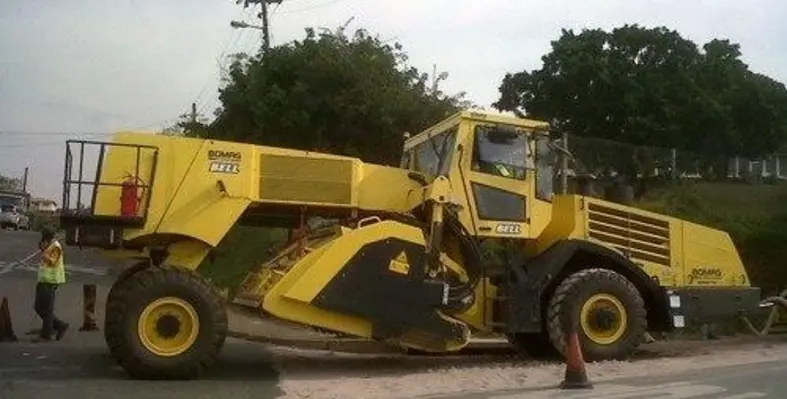Bell Equipment is seeking to become a one-stop shop, particularly in the field of road construction and rehabilitation.
The company has increased its Bomag product offering to include the Bomag MPH 125 Soil Stabiliser/Asphalt Recycler as well as the Bomag BF 600 Paver/Finisher.
Bell Equipment’s Product Marketing Manager: Bomag, Sathie Chetty said, “These machines have been part of the Bomag stable for some time and were developed in cooperation with contractors around the world to allow Bomag’s engineers to develop the highest power, reliability and efficiency in these machines. Government is making a huge drive to rehabilitate existing roads and build new ones so we saw this as an ideal opportunity to introduce these machines locally. Many of our South African roads are in desperate need of rehabilitation and soil stabilisation and we believe these machines are well suited for this work.”
The Bomag MPH 125 has been demonstrated at sites across the country and recently generated keen interest in the Tongaat and Verulam areas of KwaZulu-Natal pulverising old, damaged road surfaces and using foam bitumen technology for soil stabilisation for Milling Techniks.
“The Bomag was impressive at Tongaat because its powerful Deutz water-cooled turbocharged diesel engine, of latest design, was able to work on a gradient where a competitor machine wasn’t able to operate. The MPH 125 can cut through the asphalt layer and sub base to a depth of 550mm as a recycler. This material can then be reused to construct a new base course by adding cement and/or foam bitumen or a bitumen emulsion,” said Chetty.
“What sets the Bomag MPH 125 apart from its competitors is its optimum vision over the work area. A combination of articulated and rear axle steering delivers excellent manoeuvrability, which together with powerful rotor and travel drives, ensure consistently good mixing results and superior efficiency.”
The universally usable rotor has rotor speeds that can be freely selected under load to match the requirements of any construction task. The variable mixing compartment of the rotor will automatically adapt to any cutting depth, irrespective of the soils and materials that are being worked on. This gives a uniform mix when binder and soil are processed to ensure lowest wear and optimised power consumption.
Meanwhile Bell plans to demonstrate the BF 600 Paver at a site in Hibberdene on the KwaZulu-Natal South Coast at the end of September or early October subject to the availability of bitumen. Chetty said, “The BF 600 Paver was designed to outperform on site using the absolute minimum of technical complexity for simple operation. Importantly, it is also well suited to all types of sites from urban areas with tight conditions to multi-lane highways.”
The BF 600 has an operating weight of 16 to 18t and an engine output of 120kW. It has a maximum placing capacity of 600 tonnes per hour and a maximum placing thickness of 300mm. An advantage is the 12,4t capacity hopper, which is able to handle extra-large paving jobs.
Two individually controllable and reversible scraper belts each has a mechanical sensor to control the scraper belt depending on the chosen material volume. This provides high paving capacity and a controlled material flow. A screed produces pre-compaction of up to 93 percent and 40cm long stressed smooth steel skins deliver outstanding evenness. In addition the auger and two channel plates in the auger tunnel are supplied standard with two ultrasound sensors for even material distribution and to prevent unwanted build-up of material in front of the board.
Chetty said, “Cost effectiveness is largely achieved through the ECOMODE machine management system, which simultaneously makes intelligent use of power while reducing fuel consumption and environmental pollution. Bomag is well recognised as a world leader in compaction technology so we are confident that these latest additions will be a great complement to our existing Bomag product range and provide customers with a competitive advantage as well as a full package to meet their road rehabilitation and construction requirements.”






